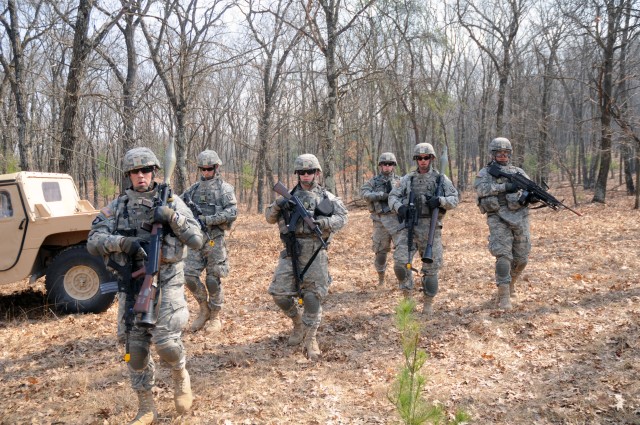
FORT McCOY, Wis. -- National Guard and Army Reserve Soldiers are deploying to a war zone in a week or two, but they still must take a final exam.
The eight-day mission rehearsal exercise (MRE) is one of the last tasks a mobilized unit must accomplish before being validated for deployment in support of Operations Iraqi Freedom (OIF) or Enduring Freedom (OEF).
Validation is certification by the 181st Infantry Brigade that the unit has successfully completed its mobilization training tasks.
The MRE is important to the mobilizing Soldier because, as Capt. Calvin Allen said, "The MRE helps mobilized units fine-tune their deployed mission essential task list (DMETL) and also their Standing Operating Procedures (SOP) to the specific area of operations they will be going to."
Allen is the Operations Officer for the 3rd, 340th Training Support Battalion. The 3rd, 340th is responsible for conducting all MREs and is one of the four battalions that make up the 181st Infantry Brigade.
In addition to accessing a unit's DMETL and SOP the MRE also assesses platoon and company collective tasks down to the individual Soldier tasks.
During an MRE, training engagements are built around enemy tactics, techniques and procedures (TTPs) from a specific region (OEF/OIF).
The training units are exposed to the training engagements to see how they react. Observer controller trainers (OCTs) then conduct after action reviews (AARs) to address the positive and negative aspects of what the Soldiers did or failed to do.
The majority of units now mobilizing at Fort McCoy are combat engineers, and most of those units are configuring into route-clearance battalions. Route-clearance units have the daunting tasks of hunting for Improvised Explosive Devises (IEDs) along main and alternative supply routes. Route clearance units primary equipment are the Buffalo, Husky and Talon robot.
The Buffalo, a mine-resistant, armor-protected (MRAP) vehicle with fork-like prongs attached to a 24-foot mechanical arm, probes and identifies IEDs, usually buried in or along a road.
The Husky detects IEDs, and the Talon is a small robot with cameras and a prong-clamp on a mechanical arm that can interrogate suspicious objects with the operators staying in the safety of an MRAP.
Route-clearance patrols are conducted day and night, almost every day of the year.
"During the MRE we mimic the conditions the unit will face in OIF or OEF," Allen said.
He also noted that the OCTs at Fort McCoy are regularly augmented with SMEs (subject matter experts) who are Soldiers from the unit currently in-theater that the training unit will replace. SMEs assist OCTs with training the unit.
The SMEs explain the specific threats they encountered in-theater to the Soldiers and explain how best to react to different types of threats.
"The SMEs are a great value," Allen said. "They drive home the point about what happened to them and what they did about it. This has been very beneficial for the Soldiers mobilizing."

Social Sharing